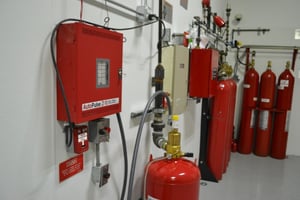Koorsen Fire Suppression Systems can be utilized in almost any environment to protect high value items and equipment. Clean Agent systems utilize gases that are safe for humans and the environment. These systems are ideal for occupied spaces that hold valuables such as hospital and medical centers, electric control rooms, banks, record storage, museums and computer and data rooms.
Systems may include any or all of the following items, depending on the fire suppression system:
- Discharge Nozzles: Releases extinguishing agent at a specific rate and pattern.
- Piping: Used to carry agent from container to nozzles.
- Control Panel: Monitors all components of the suppression system, including audible and visible alarms.
- Automatic Fire Detection Devices: Triggers the system as soon as danger has been detected.
- Container & Extinguisher Agent: Stores the extinguisher agent until it is needed.
- Discharge or Warning Alarm: Notifies occupants that the system is discharging.
Inspections are necessary every six months in order to ensure suppression agent containers are the proper weight and pressure. Annual inspections test the entire suppression system including the initiating devices, release devices, piping, nozzles, agent containers and signal. The list below represents the key steps Koorsen performs while inspecting a typical clean agent system (may vary slightly depending upon systems specifications):
- Check all initiating devices and verify time delays for system discharge.
- Ensure releasing device activates properly.
- Verify abort device and manual release functionality.
- Check weight and/or pressure of agent containers.
- Verify the orientation of all discharge, pipe fittings and nozzles.
- Perform enclosure integrity test.
- Check batteries and signal.
- Verify as-built drawing and flow calculations.
Talk to a Koorsen associate today to find out about your options for fire suppression systems and our customized service plans.



